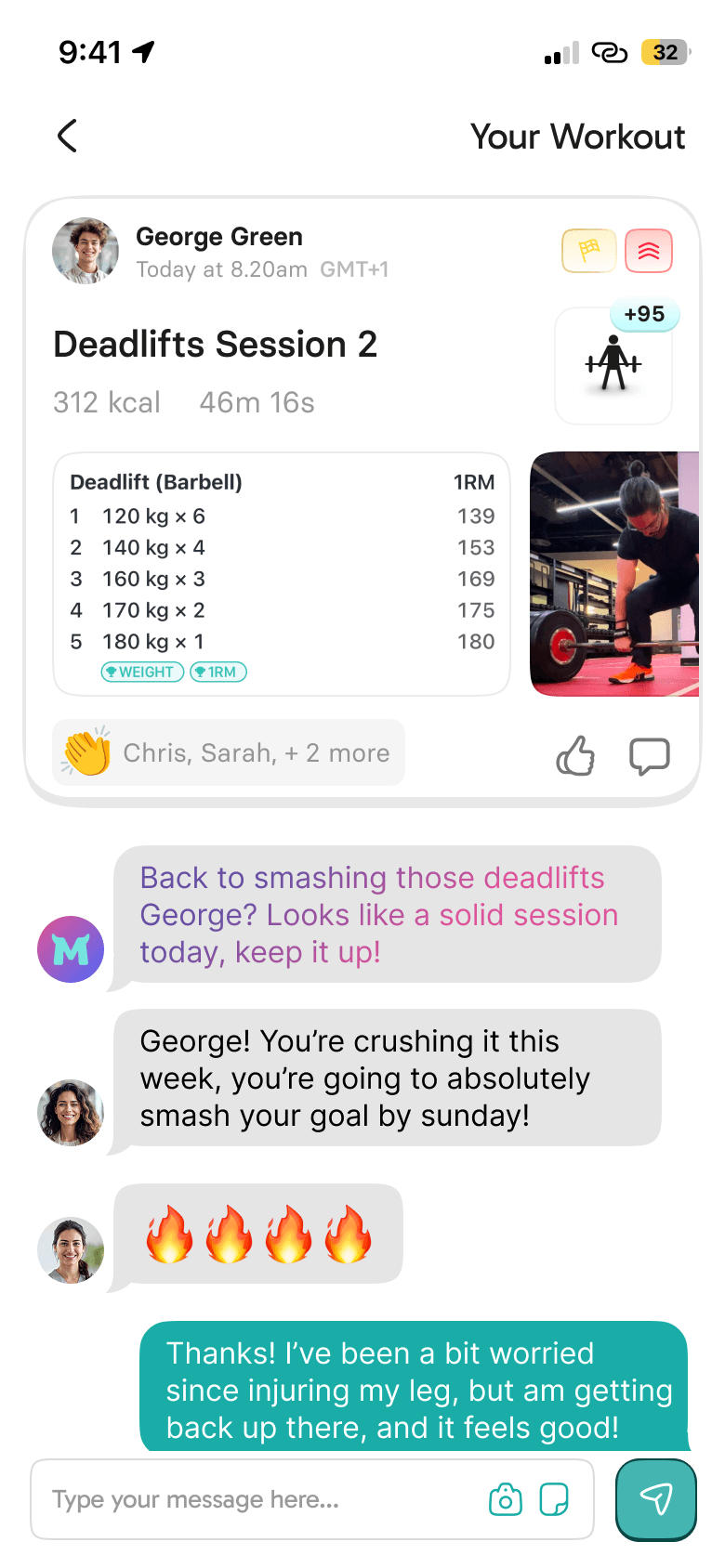Strava for Strength Training: The Afterthought Feature
Strava revolutionized running and cycling tracking. But for strength training? It's like they forgot gyms exist. If lifting is your thing, you deserve better.

The Strength Training Experience on Strava (Spoiler: There Isn't One)
How Strava "Handles" Strength Training
Step 1: Finish an intense 45-minute leg day session
Step 2: Open Strava to log it
Step 3: Manually create activity, select "Workout"
Step 4: Type "Leg day" in the title
Step 5: Get 2 pity kudos
Step 6: Watch it disappear under someone's recovery jog
What's Missing (Everything)
No Exercise Tracking
You can't log what exercises you did, sets, reps, or weight. Just "Workout - 45 minutes." That's it. Your PR on deadlifts? Strava doesn't care.
No Meaningful Metrics
Calories burned? Random estimate. Progress tracking? Nope. Volume calculations? What's that? Strava treats your carefully programmed workout like you spent 45 minutes vaguely moving around.
Zero Social Features
No one gets excited about your "Workout" post. There's no context, no achievement, no way to share what you actually accomplished. Your 2-plate bench PR gets the same recognition as "stretched for 5 minutes."
No Integration with Gym Apps
Use Strong, Fitbod, or JEFIT to actually track your lifts? Too bad. Strava doesn't integrate with any of them meaningfully. You get duration and... that's it.
The Message Is Clear
Strava is for endurance athletes who train outdoors with GPS. If you lift weights, do CrossFit, practice yoga, or enjoy group fitness classes, you're not their target audience. You're barely even acknowledged.
Why Ignoring Strength Training Is a Problem
Strength Training Isn't Optional - It's Essential
The Science Is Overwhelming
Research shows strength training:
- Increases longevity more than cardio alone
- Prevents age-related muscle loss (sarcopenia)
- Improves bone density
- Boosts metabolism for 48+ hours post-workout
- Reduces injury risk from running/cycling
Most Adults Should Prioritize Strength
The WHO and CDC guidelines recommend strength training at least twice per week. For many people, it's MORE important than cardio.
What Strength Athletes Actually Need
| Workout Structure Tracking | Progress Metrics |
|---|---|
| - Exercises performed | - Volume progression |
| - Sets, reps, and weight | - PR tracking |
| - Rest periods | - Strength gains over time |
| - Workout splits and programming | - Body part frequency |
| Exercise Selection | Community That Gets It |
| - Compound vs. isolation | - Celebrate PRs properly |
| - Share workout programs | - No GPS required |
| - Form checks and advice | - Indoor-friendly |
| - Motivation for heavy sets | - Flexible duration tracking |
Apps That Actually Respect Your Gains
Motion: Where All Movement Counts Equally
Motion treats your strength training with the respect it deserves:
- Full Credit for Gym Work: Your 45-minute lifting session counts the same as anyone's 45-minute run
- Effort-Based Recognition: Your goals account for ALL your activity, not just cardio
- No GPS Required: Perfect for indoor workouts
- Flexible Tracking: Log it however you want - Motion cares that you moved, not how
- Supportive Community: Gym rats, yogis, runners - everyone's welcome
Your virtual pet gets just as happy from your deadlifts as from anyone's marathon!
Specialized Strength Apps
Strong / Fitbod / JEFIT
Dedicated lifting apps with exercise databases, programming, and detailed tracking. Excellent for serious lifters but lack the social/gamification aspects.
Hevy
Social strength training app - like Strava but actually built for lifting. Share workouts, not just durations.
Apple Fitness+ / Google Fit
Basic workout tracking that at least acknowledges strength training exists.
The Hybrid Approach
Many lifters use:
- Specialized app for detailed workout tracking
- Motion for overall fitness gamification and community
- Strava only if they also run/cycle
There's no rule saying Strava has to be your only fitness app, especially when it ignores half your training!
Heard enough?
Experience the difference with Motion's unique approach to fitness.
If You Must Use Strava for Strength Training
Workarounds for the Desperate
1. Get Creative with Titles
Instead of "Workout," write "Leg Day: 5x5 Squats @ 225lb, PR!" At least people know what you did.
2. Use the Description Field
List your entire workout in the description. It's tedious but better than nothing.
3. Add Photos
Gym selfies and PR videos get more engagement than "Workout - 45 min."
4. Find Strength-Focused Groups
They exist but are hard to find. Search for "Powerlifting," "Bodybuilding," or "CrossFit" groups.
5. Track Cardio Separately
If you do cardio too, post that to Strava for engagement, track strength elsewhere.
Or Admit Strava Isn't For You
It's okay to acknowledge that Strava, despite being popular, doesn't serve strength athletes well. You wouldn't use a running shoe for squatting - why use a running app for lifting?
Motion and other apps value ALL movement equally. Your strength training deserves to be celebrated, not hidden behind "Workout - 45 min."
The Bottom Line
Strava revolutionized endurance sports tracking. But acting like strength training doesn't matter in 2025? That's not just outdated - it's actively harmful to people's fitness journeys.
Choose apps that celebrate your actual training, not just the parts with GPS data.
Frequently asked questions
If you have anything else you want to ask, reach out to us.
Can Strava track weight lifting?
Technically yes, but poorly. You can log 'Workout' as an activity type with duration, but can't track exercises, sets, reps, or weight. It's basically a time stamp with no useful information.
Why doesn't Strava have better strength training features?
Strava's built around GPS-tracked endurance activities. Strength training doesn't fit their model - no routes, no segments, no pace data. They've chosen to focus on running/cycling rather than expand to gym work.
What's the best app for tracking strength training?
For detailed lifting: Strong, Hevy, or Fitbod. For overall fitness including strength: Motion values all movement equally. Many people use a specialized lifting app plus Motion for motivation and community.
Do Strava fitness scores include strength training?
Barely. Without heart rate data, strength workouts contribute minimally to fitness scores. Even with HR, Strava's algorithms are designed for cardio, not resistance training. Your gains are basically invisible.
Can I connect my gym app to Strava?
Some apps can push basic workout data to Strava, but it just shows as 'Workout' with duration. All the actual lifting data (exercises, sets, weight) gets lost in translation.
Should strength athletes use Strava?
Only if you also do cardio you want to track. For pure strength training, you're better off with Motion for general fitness tracking or specialized apps like Hevy for detailed workout logging. Strava offers nothing for lifters.
How does Motion handle strength training differently?
Motion counts all movement toward your weekly activity goals - lifting, cardio, yoga, everything. Your <a gref="/adaptive-ai-fitness-goals/">adaptive goals</a> factor in all your training, and the community celebrates gains as much as miles.

